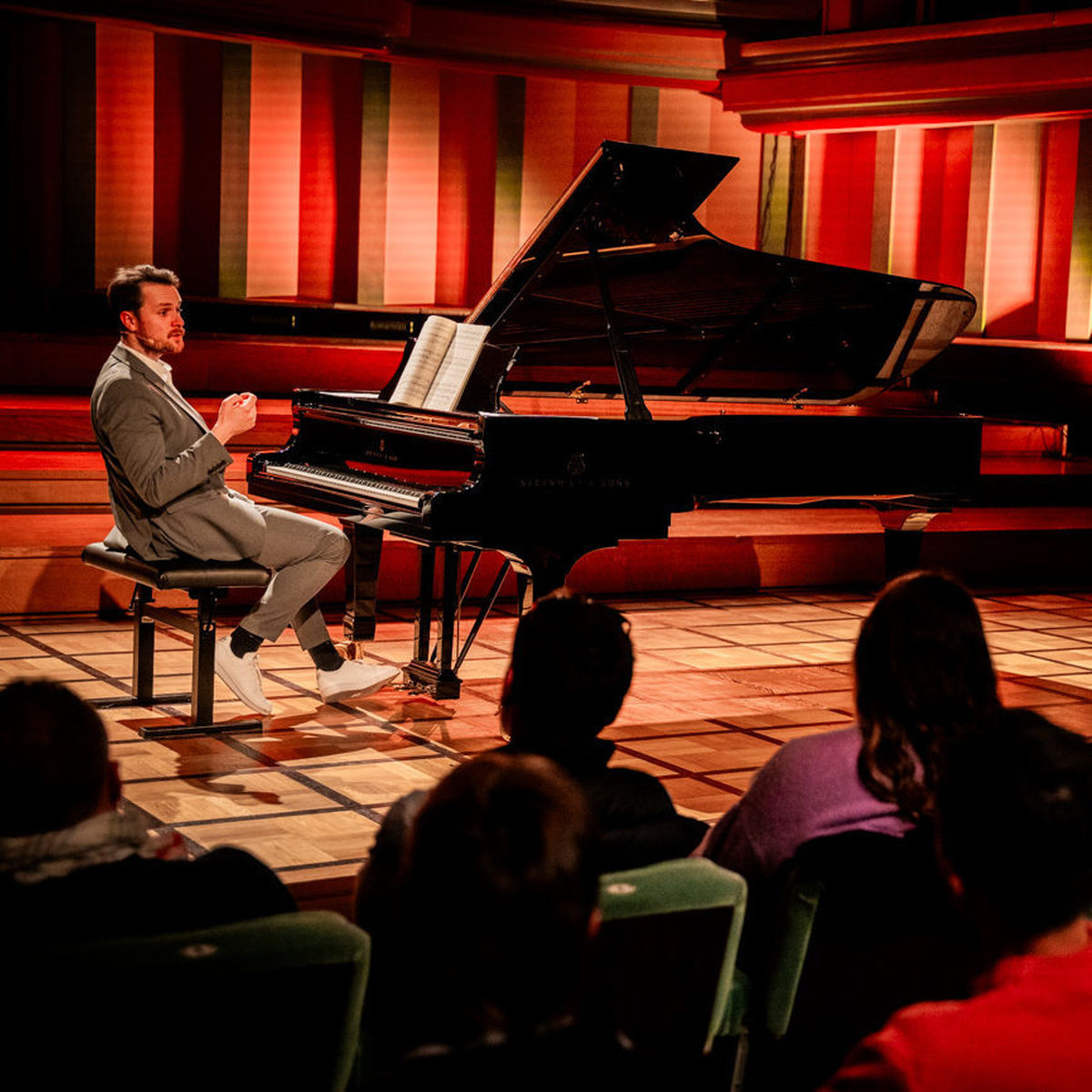
Daphnis & Chloé

PROGRAMME NOTES
written by AURÉLIE WALSCHAERT
Annelies Van Parys EUtopia (2024)
Nadia Boulanger Fantaisie variée pour piano et orchestre (1912)
—
Maurice Ravel Daphnis et Chloé (1912)
visual concept by Lisette Ma Neza (poetry) & Gerd Van Looy (artistic coordination)
-----
26.09.2025 FLAGEY BRUSSELS
27.09.2025 CONCERTGEBOUW BRUGGE
Daphnis & Chloé
At the beginning of the 20th century, Paris was the cultural place to be. The French capital was a bustling crossroads of art, music and literature, and attracted artists from across Europe and far beyond. In 1909, the Russian impresario Sergei Diaghilev came to the city of light in order to put his Ballets Russes on the international map. Shortly before then, the young choreographer Michael Fokine had offered him a libretto based on the Greek love story of Daphnis and Chloe. Diaghilev was enthusiastic at the idea, and asked Maurice Ravel (1875-1937) to write the music. Ravel was honoured to accept the task, although he did not have a traditional ballet in mind. He described it as a ‘symphonie choréographique’ in which colour, mood and elegance were at the forefront. The process of composition was laborious, but ultimately gave us one the finest orchestral works of the last century.
Paris was known at the time not only as the breeding ground of artistic creation and experimentation. The musical training provided by the Paris Conservatoire and a few private teachers was renowned around the world. One of the most influential of those teachers was Nadia Boulanger (1887–1979). In her apartment in the Rue Ballu, she taught more than 250 students, including Leonard Bernstein, Philip Glass and Aaron Copland. And although from 1910 she focused mainly on teaching and conducting, she also wrote a few undervalued works, including her Fantaisie variée pour piano et orchestre.
What remains in 2025 – two world wars, various social upheavals and geopolitical crises later – from the ideal of progress that resounded so loudly at the beginning of the 20th century? This question is partly at the basis of Annelies Van Parys’ EUtopia, a commissioned work written in 2024 for the European Union Youth Orchestra. Is there still hope for European ideals such as brotherhood and peace, or do only echoes of that dream still survive?
‘Initially, I thought of writing a hopeful message. But when, during the summer of 2023, I began to gather the first materials, there were political deals being concluded to keep people outside Europe’s borders. In a way that, to my mind, were not in line with European values.’
Between hope and utopia
When Annelies Van Parys (1975) was given a commission to write an orchestral work for the European Union Youth Orchestra, she focused on the European ideals that are also expressed in Schiller’s famous Ode to Joy.
This observation inevitably found expression in the music. EUtopia begins on a hopeful note, with harmonic sounds and natural images. And with a nod to dodecaphony and serialism, two techniques of composition techniques that announced innovation in the postwar era. Along the way, the optimistic sounds give way to harsh orchestral colours, noises make their appearance and the texture swells into a dense mass of sound. And then we hear the melody from Beethoven’s ‘alle Menschen werden Brüder’ (Ode to Joy), albeit almost unrecognizably, in stretched out notes and sounds that evoke the tolling of bells. First in a major key, and later in minor. How strongly is the aspiration of the European project still heard today?
Advocate of the French musical tradition
At a time when the musical world seemed almost completely out of bounds for women, Nadia Boulanger blazed a trail as a composer, conductor and music teacher. As a result, she opened the doors for the next generation and left an indelible mark on 20th-century classical music. Encouraged by her father, the composer and voice teacher Ernest Boulanger, she began writing music at an early age. From the age of nine, she studied composition at the Paris Conservatoire with, among others, Gabriël Fauré, and when she was 21, she won second prize at the prestigious Prix de Rome for her cantata La Sirène.
Nadia Boulanger’s output includes lieder, chamber music, works for piano, choral music and a number of orchestral works, in a style that is close to French impressionism. She wrote the single-movement Fantaisie variée pour piano et orchestre in 1912 for her teacher and close friend Raoul Pugno. He mounted the première with Boulanger as conductor.
Nadia Boulanger herself was not convinced of her talent as a composer. ‘If there is one thing I am sure of, it’s that I have written useless music.’ After the death of her sister Lili, whom she considered a far better composer, she would only teach and conduct. Her compositions fell into oblivion, but have seen a revival since the beginning of this century, thanks partly to ambassadors such as the pianist Alexandra Dariescu. She was, by her own admission, enthused from her first reading ‘by the lively energy, daring harmonic language and pure originality’ of the Fantaisie.
A musical fresco
The score which Ravel wrote for Daphnis et Chloé is a daring and typical expression of his unique style. The choreographer Michel Fokine had based the libretto for the ballet on the pastoral account of the same name by the Greek author Longus. In the story, the shepherds Daphnis and Chloe experience an idyllic love story, until one day Chloe is kidnapped by pirates. Daphnis follows her, loses consciousness and, while asleep, is overcome with visions in which the god Pan frees Chloe. All’s well that ends well: at dawn, the lovers are reunited.
The ballet is one of the longest of Ravel’s works; not only does it require an enormous orchestra, but also a choir singing without a text both from the stage and behind the scenes. He worked on it for almost three years, from 1909 to 1912. As a result of a considerable number of differences of opinion between Ravel and Fokine, the première kept being postponed. Ravel had in mind a large-scale musical fresco, by analogy with the Greek landscapes by French painters at the end of the 18th century, but that did not fit in with the archaic vision of the Russian choreographer. In addition, the rehearsals were hardly smooth: the dancers had difficulty with the unusual rhythms and the lack of sufficient rehearsal time made things even more tense. Nor was Diaghilev entirely satisfied with the music, which in his view was more symphonic than choreographic in nature.Of the four planned performances in June 1912 in the Théâtre du Châtelet in Paris, only two took place. At the end, Ravel refused to greet the audience. Even before the première, he reworked the first two scenes of the ballet into the first of his orchestral suites, and shortly thereafter he put together a second suite. These turned out to be the most popular, thanks in part to the well-known Lever du jour. The musical expression of the moment when the two lovers are reunited is one of the most poetic musical renditions of a nature scene: the rustling of the trees and the birdsong at sunrise lead into a passionate melody. The following movement, with the flute in the main role, is an ode to the gods Pan and Syrinx. The work ends with an exuberant dance of praise in 5/4 time that the dancers had found so difficult.


PRESS PLAY: love & romance
From tender classics to dramatic passion—these timeless romantic films perfectly match the mood of Daphnis et Chloé.
Daphnis et Chloé (26.09.2025)

Ravel Deconstructed · Florestan Bataillie · 26.09.2025
During this musical lecture, the passionate pianist and storyteller Florestan Bataillie guides you through the enchanting world of Ravel's Daphnis et Chloé. With fervor, he unravels the masterpiece and reveals how Ravel, inspired by ancient Greek love tales, created a unique musical universe where every note comes alive. Whether you’re already an aficionado or simply curious, everyone is welcome, and no prior knowledge is required!

Curated by... Alexandra Dariescu
Alexandra Dariescu – pianist and changemaker – shares her favourite tracks: from Clara Schumann to Björk

Composer's note
"Europe: from ideal to utopia?" - read Annelies Van Parys’ note on her composition EUtopia

Meet Nadia Boulanger
an extraordinary composer, conductor and music teacher: Nadia Boulanger in a nutshell
